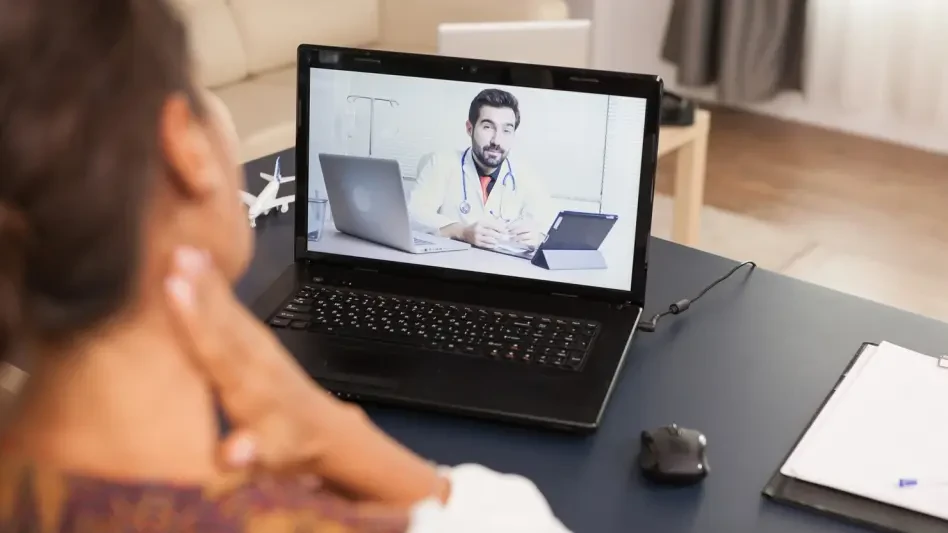Understanding COPD and the Role of Telemedicine
Chronic Obstructive Pulmonary Disease (COPD) stands as a formidable global health challenge, affecting millions of individuals and placing immense pressure on healthcare systems worldwide. This progressive respiratory condition, characterized by airflow limitation, often leads to debilitating symptoms and frequent acute exacerbations that result in hospitalizations. The burden extends beyond patients to caregivers and providers, with significant economic costs tied to emergency care and long-term management. Addressing this crisis requires innovative solutions that can enhance patient outcomes while alleviating strain on medical resources.
Telemedicine emerges as a promising approach to managing chronic conditions like COPD, offering a pathway to deliver care remotely through digital platforms. This technology enables healthcare providers to monitor patients, conduct consultations, and provide real-time interventions without the need for physical visits. Its relevance for COPD care lies in the ability to maintain consistent contact with patients who may struggle with mobility or live in remote areas, ensuring timely responses to worsening symptoms. The integration of telemedicine into routine care represents a shift toward more accessible and efficient health services.
The current state of telemedicine in healthcare reflects rapid adoption, driven by advancements in remote monitoring tools, video conferencing platforms, and wearable devices. Key stakeholders, including healthcare providers, technology companies, and policymakers, are actively shaping this landscape by developing secure systems and expanding connectivity. The significance of these tools is evident in their potential to reduce hospital readmissions for COPD patients by detecting early signs of exacerbations and enabling prompt treatment adjustments. As telemedicine continues to evolve, its capacity to transform chronic disease management becomes increasingly apparent.
Evaluating Telemedicine’s Impact on COPD Management
Key Findings from Recent Studies
Recent research underscores the transformative potential of telemedicine in enhancing COPD care, particularly for patients with severe disease stages. Studies reveal notable improvements in quality of life (QOL) among those receiving virtual follow-ups, as measured by tools like the COPD Assessment Test (CAT). For instance, patients in telemedicine groups often report significantly lower CAT scores over time compared to those under traditional care, indicating better symptom control and daily functioning. These outcomes highlight the value of consistent remote engagement in managing a condition that severely impacts routine life.
Beyond QOL, telemedicine has shown remarkable success in improving inhaler technique, a critical factor in effective COPD treatment. Data indicates that a high percentage of patients under remote supervision achieve correct inhaler use after receiving real-time feedback during video consultations, far surpassing rates seen in standard in-person settings. This targeted instruction helps ensure proper medication delivery, directly influencing disease progression and reducing exacerbation risks. Such findings emphasize the practical benefits of digital interventions in skill-building for chronic care.
Patient satisfaction also trends positively with telemedicine, as many express a preference for virtual follow-ups due to their convenience and accessibility. The ability to receive immediate guidance without the burden of travel fosters a sense of support and reduces anxiety about managing the condition. This feedback loop, facilitated by digital platforms, not only boosts adherence to treatment plans but also strengthens the therapeutic relationship, paving the way for sustained health improvements.
Broader Trends and Market Insights
The growing acceptance of telemedicine as a cornerstone of chronic disease management is supported by extensive literature and comprehensive reviews. This shift is driven by the urgent need to lessen the load on overburdened healthcare systems while ensuring patients receive continuous care. Market data suggests that digital health solutions are gaining traction, with providers and patients alike recognizing their capacity to bridge gaps in access, especially for those hindered by geographic or physical barriers. The momentum behind telemedicine reflects a broader movement toward patient-centric care models.
Looking at market drivers, the push to integrate telemedicine into COPD management aligns with efforts to optimize resource allocation and enhance care delivery. Projections indicate a steady rise in adoption rates over the coming years, fueled by positive patient experiences and the scalability of digital tools. From this year to 2027, industry analysts anticipate significant growth in telehealth services as infrastructure improves and more stakeholders invest in these technologies. This trend signals a potential reshaping of how chronic respiratory conditions are approached on a systemic level.
A forward-looking perspective reveals that telemedicine could redefine standards of care for COPD by prioritizing accessibility and personalization. As feedback from users continues to inform platform development, the focus remains on creating seamless experiences that cater to diverse patient needs. The convergence of technological innovation and healthcare delivery holds promise for a future where remote interventions become a norm rather than an exception, fundamentally altering the landscape of chronic disease support.
Challenges in Implementing Telemedicine for COPD Care
Implementing telemedicine for COPD care is not without hurdles, particularly when it comes to technological barriers. Many patients, especially older adults or those in underserved regions, lack access to reliable internet or compatible devices necessary for virtual consultations. This digital divide risks excluding vulnerable populations from benefiting from remote care, thereby widening existing health disparities. Addressing this gap requires targeted strategies to ensure equitable access to essential tools.
Beyond technology, patient engagement poses another significant challenge, as some individuals may struggle to adapt to virtual platforms or feel disconnected due to the lack of personal interaction. Concerns over data privacy also loom large, with fears of breaches or misuse of sensitive health information deterring participation. These issues can undermine trust in telemedicine systems, necessitating robust safeguards and transparent communication to reassure users about the security of their data.
Solutions to these obstacles include comprehensive training programs for both patients and providers to build familiarity with digital tools. Investments in secure, user-friendly platforms can mitigate privacy risks while enhancing usability. Additionally, hybrid care models that combine virtual and in-person elements may help maintain a human touch in treatment, balancing efficiency with empathy. Overcoming these challenges is essential to unlocking the full potential of telemedicine in chronic respiratory care.
Regulatory and Ethical Considerations in Telemedicine
The regulatory landscape for telemedicine encompasses a complex web of data protection laws, reimbursement policies, and compliance standards that shape its implementation. Governments and health authorities are tasked with establishing frameworks that protect patient information while facilitating the integration of digital care into mainstream systems. Navigating these regulations is crucial for providers to ensure that virtual services meet legal and ethical benchmarks without compromising quality.
Patient privacy and security remain paramount concerns in virtual care platforms, as the risk of data breaches or unauthorized access threatens confidentiality. Ensuring robust encryption and adherence to strict protocols is non-negotiable to maintain trust and safeguard sensitive information. Ethical considerations also extend to informed consent, requiring clear communication about how data is handled and shared during remote interactions. These measures are vital for fostering confidence in telemedicine adoption.
Evolving regulatory standards can either support or hinder the broader rollout of telemedicine in COPD care, depending on their adaptability to technological advancements. Policies that streamline reimbursement for virtual services and incentivize innovation tend to accelerate integration, while overly restrictive guidelines may stifle progress. Striking a balance between oversight and flexibility is key to creating an environment where telemedicine can thrive as a legitimate and sustainable component of healthcare delivery.
The Future of Telemedicine in COPD Management
Looking ahead, telemedicine in COPD care is poised to benefit from emerging technologies such as wearable devices that enable real-time symptom monitoring. Innovations like AI-driven prediction models could anticipate exacerbations before they occur, allowing for preemptive interventions. These advancements promise to elevate the precision and responsiveness of remote care, tailoring solutions to individual patient profiles with unprecedented accuracy.
Potential disruptors, including rapid developments in digital health tools and shifting patient expectations, are likely to redefine care paradigms. As individuals increasingly demand accessible and personalized services, providers must adapt by leveraging integrated platforms that sync with electronic health records. Expanding telehealth to rural or underserved populations also represents a critical growth area, addressing systemic inequities through scalable digital outreach.
External factors such as global health policies and economic conditions will inevitably influence telemedicine’s trajectory in chronic disease management. Supportive legislation and funding can accelerate deployment, while economic downturns might constrain resources for infrastructure upgrades. The interplay of these elements will determine how swiftly and effectively telemedicine integrates into routine COPD care, shaping its long-term impact on public health.
Conclusion and Recommendations for Advancing COPD Care
Reflecting on the insights gathered, telemedicine demonstrates substantial promise in enhancing quality of life, inhaler technique, and patient satisfaction for those managing COPD. The evidence points to meaningful improvements in symptom control and treatment adherence through virtual interventions, underscoring a viable alternative to traditional models. High user acceptance further validates its role in modern healthcare delivery.
To build on these advancements, stakeholders need to prioritize actionable steps that address lingering limitations. Expanding clinical trials to encompass diverse populations ensures that findings apply across varied contexts, while bolstering technical infrastructure tackles access disparities. Advocacy for supportive regulations emerges as a crucial measure to sustain telemedicine’s growth, guaranteeing that privacy and reimbursement frameworks align with innovation.
Ultimately, the journey toward integrating telemedicine into COPD management demands a collaborative push for systemic enhancements. Investing in long-term research to refine digital tools and fostering partnerships between tech developers and healthcare providers offers a roadmap for success. These efforts aim to solidify telemedicine as a cornerstone of chronic care, ensuring better outcomes for patients navigating respiratory challenges.









